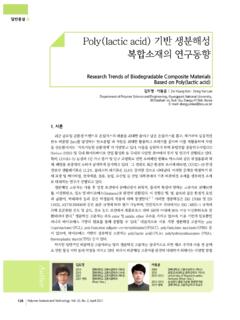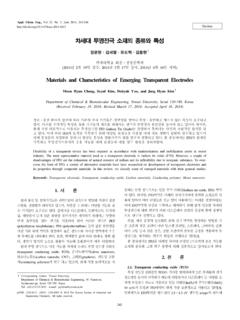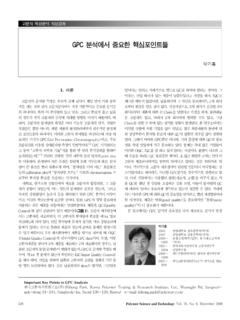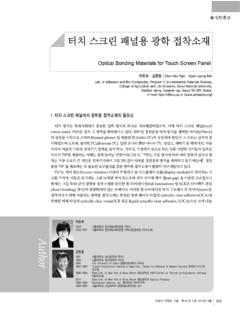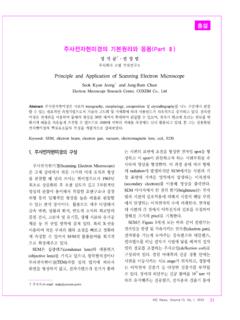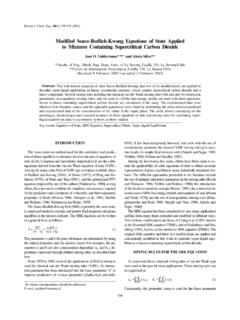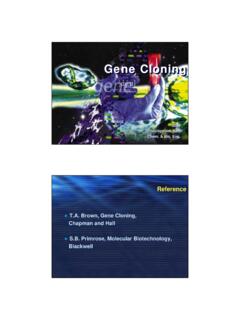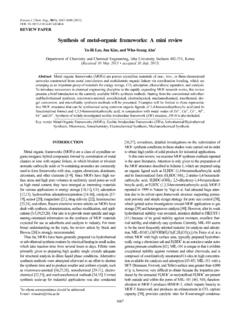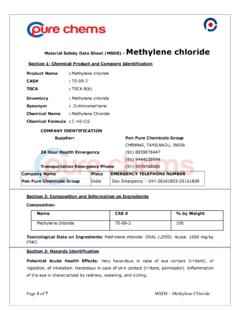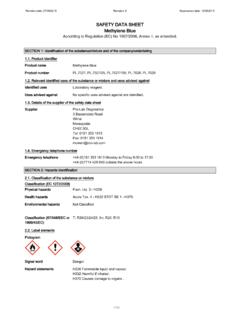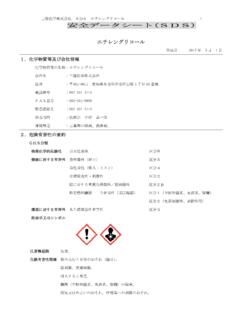Transcription of Ethylene Glycols Technology - CHERIC
1 Korean J. Chem. Eng., 18(5), 571-579 (2001)FEATURED REVIEW571 The author is Principal Engineer with Dye Engineering and TechnologyCompany at the address shown above. USA phone: 281-494-5617;fax: 281-494-0210; no Glycols TechnologyRobert Fulton Dye3011 Fairway Drive, Sugar Land, TX 77478, USAA bstract Ethylene glycol (EG) or monoethylene glycol (MEG), the adduct of Ethylene oxide (EO) and water, isthe simplest glycol. It is the first of a homologous series of three dihydroxy alcohols discussed in this article. Diethyleneand triethylene Glycols (DEG, TEG) are the other two.
2 These Glycols are composed solely of carbon, hydrogen andoxygen. Although they have similar chemical properties, their applications vary mainly with physical properties suchas viscosity, hygroscopicity and boiling point. The commercial route to Ethylene Glycols in use today involves the non-catalyzed thermal hydrolysis of Ethylene oxide in water. This process produces chiefly mono-, di- and triethyleneglycols and a small amount of tetraethylene and heavier Glycols . The yield of monoethylene glycol via hydrolysis iscontrolled by the water-to- Ethylene oxide ratio in the feed to the reactor system.
3 Removal of excess water followingthe Glycols -forming hydrolysis is energy intensive and requires capital investment in evaporators. Such costs limit theamount of excess water which is used. In practice, reactor feed water content is such that the selectivity tomonoethylene glycol achieved ranges from 89-91%. The equipment elements in a simplified process flow diagramare discussed along with recommended materials of construction. Among other items discussed are a) a brief reviewof economic factors; b) health, safety and environmental issues; and c) commercial applications of the three Glycols ,MEG, DEG and TEG.
4 Finally, recommendations for shipping, handling and storage are words: Monoethylene Glycol, Thermal Hydrolysis, Properties, Toxicology/Environmental, ApplicationsINTRODUCTION1. GeneralEthylene glycol (EG), the principal topic discussed in this articleis also interchangeably referred to as monoethylene glycol (MEG). Ethylene glycol is the adduct of Ethylene oxide (EO) and water andis the simplest glycol, the first of a homologous series of three dihy-droxy alcohols, namely, mono-, di- and triethylene Glycols (MEG,DEG and TEG). These Glycols contain two hydroxyl groups at-tached to separate carbon atoms in an aliphatic chain.
5 Diethyleneand triethylene Glycols , and tetraethylene Glycols , which some authorsalso discuss, are oligomers of Ethylene glycol. Not discussed exten-sively are polyglycols. Polyglycols are higher molecular weight ad-ducts of Ethylene oxide distinguished by intervening ether linkagesin the hydrocarbon chain. Polyglycols are commercially importantand have properties that vary with molecular weight, are water solu-ble, hygroscopic, and undergo reactions common to the lower mole-cular weight 1. Properties of glycolsPropertyEthylene glycolDiethylene glycolTriethylene glycolMolecular point@760 mmHg, kg/ m3@40oC109911031109 Coefficient of expansion@20oCper point, cleveland open cup, oC115143165 Freezing point at 760 mmHg, oC index, @20oC, pressure, of vaporization@760 mmHg, cal/gm1918399 Thermal conductivity, cal/(sec)(cm2) tension, heat, solubilitycompletecompletecompleteSource : Shell Bull.
6 , F. DyeSeptember, 2001 The three Glycols (mono-, di- and triethylene glycol) discussed arecomposed solely of carbon, hydrogen and oxygen and have similarchemical properties. They have applications that vary mainly withphysical properties such as viscosity, hygroscopicity and boiling StructuresThe three Glycols have the following structures and synonyms: Ethylene GlycolHOCH2 CH2OH(Monoethylene Glycol, EG or MEG)Diethylene GlycolHOCH2 CH2 OCH2CH2OH(DEG)Triethylene GlycolHOCH2 CH2 OCH2CH2 OCH2CH2OH(TEG)PHYSICAL PROPERTIEST able 1 lists various physical properties and constants for the ethyl-ene , di- and triethylene Glycols are colorless, odorless, highboiling, hygroscopic liquids that are completely miscible in waterand a number of organic pressure curves for the Ethylene Glycols at various tem-peratures are illustrated in Fig.
7 1. Another important property, ethyl-ene Glycols can reduce the freezing point of water markedly as shownin Fig. PROPERTIESThe presence of two hydroxyl groups in the glycol molecule de-termines its chemistry and permits reactions such as esterification,dehydration, oxidation, halogenation and formation of alcoholatesand acetals to take place. In the following examples, Ethylene glycolis used to illustrate some of its reaction Esters of Organic AcidsOrganic acids, anhydrides, and acid chlorides react with the gly-cols to yield mono- and diesters.
8 The molar ratio of the acid to theglycol determines which product will 1. Vapor pressures of : Shell Bull., 2. Freezing points of monoethylene glycol, diethylene glycoland triethylene glycol aqueous : Shell Bull., Glycols Technology573 Korean J. Chem. Eng.(Vol. 18, No. 5)2. Polyesters of Polybasic AcidsPolybasic acids or their derivatives will react with the Glycols toform polyesters. Depending on whether an excess of acid or glycolis used, the polymer may be terminated with either alcohol or DehydrationDepending on the catalyst and conditions used the dehydrationof Ethylene glycol yields aldehydes, alkyl ethers and cyclic ethers,such as OxidationThe oxidation of Ethylene glycol by various methods yields ace-taldehyde, formaldehyde, glycolic acid, oxalic acid, and is the most important oxidation product.
9 The course of thereaction is dependent on the reaction Other ReactionsThe reaction of the Ethylene Glycols with Ethylene oxide leads tothe formation of ether-alcohols. The product composition is gov-erned by the ratio of the Process HistoryEthylene glycol was first prepared by Wurtz in 1859 by the hy-drolysis of Ethylene glycol diacetate but was not of commercial in-terest until World War I, when it was used in Germany as a sub-stitute for glycerol in explosives production [Curme and Johnston,1952]. Later, in the 1930 s, when the commercial use of the Lefortdirect oxidation route to Ethylene oxide began to displace the chlo-rohydrin process, hydrolysis of the oxide to Ethylene glycol cameinto favor.
10 Ethylene glycol was originally produced commerciallyin the United States from Ethylene hydrolysis with both acid and base catalysts are provenmethods for Ethylene glycol production, neutral non-catalyzed hy-drolysis has been shown to be equally as popular. In time, the lattergained acceptance as the favored choice used for commercial pro-duction. Today there are no known industrial producers of ethyleneglycol via catalytic hydrolysis of Ethylene hydrolysis (pH 6-10) carried out in the presence of a largeexcess of water at high temperature and pressure, gives selectivitiesto monoethylene glycol in the 89-91% range.
